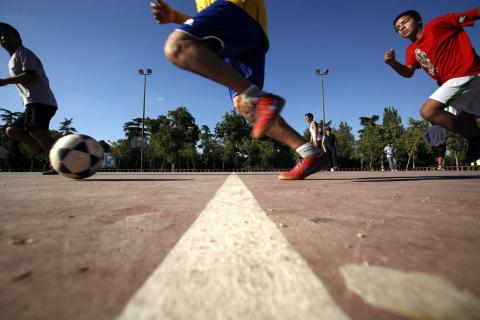What are we talking about when we talk about a continuous or split working day?
The continuous working day, also called intensive working day, means that all teaching hours are grouped together in the morning. The split working day, on the other hand, divides them between morning and afternoon and includes a long lunch break.
How many schools in Spain have a continuous or split school day, and does the proportion vary between public and private/subsidised schools, with different timetables for primary and secondary schools?
There are no official data that allow us to know the exact distribution of timetables. However, the continuous school day already seems to be the majority in infant and primary education in public schools in all autonomous communities except in Catalonia and the Basque Country, where it is established that it must be compulsorily split.
Maldita.es requested the data from all the autonomous communities at the beginning of 2023. They received a response from 12 of them regarding public schools and from seven regarding private/concerted schools. Overall, 81 % of the responding public schools have a continuous school day in pre-primary and primary education - in some Communities such as Murcia, Extremadura and the Canary Islands it is 100 %. In private/contracted schools, the proportion is reversed: 77 % have a split day.
In secondary education, it is even more difficult to obtain specific data, but the continuous school day is the majority. Again, it is only in Catalonia and the Basque Country that there is a greater effort to promote the split school day.
What do the studies say about the effect of each type of working day on academic results?
In general, not much work exists and the methods used do not allow for solid conclusions to be drawn. Marta Ferrero, professor and vice-dean of research and transfer at the Faculty of Teacher Training and Education at the Autonomous University of Madrid and a former teacher and guidance counsellor, tells SMC Spain: "We have to be cautious, because there is not much research at national or international level and the studies tend to be correlational, not causal. In fact, we are missing a magnificent opportunity at the moment: we have a natural laboratory with very similar schools that are opting for different days, but we are not taking advantage of it to carry out studies that allow us to analyse their results. However, the data we have do not at any time suggest that there is a benefit to the continuous school day".
In general, research indicates that the split school day is associated with better academic results. A study carried out in the 1990s by the Galician Ministry of Education showed that there were 10 to 20 % more school failures in schools with a continuous school day. In Andalusia, a 2002 study found higher performance among pupils with a split-day timetable: in these schools, the percentage of pupils with no problems in any subject was 8 % higher than that of pupils in schools with a continuous school day. A study conducted by the Consejería de Educación de Madrid with 6th grade pupils in 2014 found that pupils with a split timetable performed better (6.9 versus 6.7 in the CDI knowledge and essential skills tests, results that had already been observed in 2008 and 2010). With regard to the PISA reports, and as stated in a report by the Bofill Foundation (and as has been observed in some exploratory studies), "the compact timetable does not seem to have provided a satisfactory response to the initial expectations of improved school performance in the Autonomous Communities where the continuous school day has been implemented".
One of the problems with these studies is that they may be biased by the socio-economic level of the families, as it has been observed that the higher the level, the greater the tendency to schooling in schools with a split day. A 2019 study in Madrid attempted to disentangle this relationship by looking at the average mathematics grades of 3rd grade primary school pupils. Pupils in schools with a split school day had an average mark of 7.16, compared to 6.77 for those with a continuous school day. When analysed by socio-economic level, the average mark is still higher for pupils from low, lower-middle and middle socio-economic levels. On the other hand, it is slightly lower in the upper-middle and high socio-economic levels.
What does research conclude about the effect of each type of day on student attention and fatigue?
One of the arguments often used in favour of the continuous working day is that early afternoon is the time when attention levels fall the most. However, most studies contradict this claim. In infant and primary school, although there are variations in the hours of maximum attention according to age, the greatest fatigue and lower attention span tend to occur in the late morning during the continuous school day. A 1993 study in Galicia detected the peak of fatigue in this type of day between 1 and 2 p.m., when 47 % of pupils admitted feeling fatigued. The peak of fatigue in the split day was between 4 and 5 p.m., affecting only 27%. According to Ferrero in a meeting with journalists organised by SMC Spain, "the general curve of attention is close to the organisation of the split day and certainly does not conform to the continuous one". The Valencian Society of Paediatrics also made the same point in a statement, saying that in the design of the day, "all the bodies involved should participate, (...) [but] it would be a mistake to ignore the teachings derived from chronobiology, chronopsychology and chrononutrition".
What evidence is there on sleep patterns?
Although many of the studies and information focus on the infant and primary school stages, it is well known that in adolescents the sleep pattern changes and is delayed, which leads us to think about the convenience of starting the school day later. However, the continuous school day, which is almost completely generalised in Spain at this age, means that many schools start classes before 9 am. "As they have greater autonomy, their timetables do not affect families as much as those of infants and primary school children, but special attention should be paid to them: their sleep patterns do not benefit from such early start times," says Ferrero. According to Daniel Gabaldón, educational sociologist and lecturer in Sociology of Education at the University of Valencia, during the meeting with journalists, "a split school day is good for secondary schools, but if it has to be intensive, it should be in the evening".
How does the type of day influence pupils' social and emotional well-being, according to research?
Although quality rather than quantity of hours is more important, more time in school is generally associated with higher achievement, particularly among students from more disadvantaged backgrounds. Similarly, several international studies show that reforms that promoted full-time schools were associated with improvements in socio-emotional and behavioural indicators, especially also in lower-income households. In these cases, moreover, eating at school favours dietary quality. However, although 72.5 % of public primary schools in Spain have a school canteen, only 38.6 % of pupils in these schools use the canteen.
According to a Save the Children report, more children and adolescents go to the school canteen in state-subsidised and private schools, despite the fact that there are far more disadvantaged pupils in the public school network. "There are many benefits to choosing a split school day and having a canteen service," says Ferrero. "Public schools serve families with very diverse profiles and, as such, can serve as a protective shield against adverse realities and promote the well-being of their students. The task of schools is to educate, but they also have a key social function and can promote equity in many ways," he adds.
One of the criticisms often levelled at the split school day and the canteen service is that it is during non-school hours that most bullying and harassment tends to occur. However, for Ferrero, "this is taking the part for the whole". "I don't think it's a question of eliminating these times, but rather of developing playground and dining room projects, because they are also a time for learning. Moreover, in the case of the continuous school day, it is usually a canteen assistant who parents meet at the time of pick-up, but there is no mention of the pedagogical value of the tutor collecting with his or her students what they have experienced and learned during the second part of the day; or that both he or she and the families have the possibility of meeting and sharing important information, if there is any. These are important issues that are not often discussed and debated.
What kind of working day exists in other European countries?
According to a report by the Bofill Foundation, there is "the belief that the intensive working day is very common in Europe", which "has helped to spread the image of greater modernity with respect to the obsolete split working day, while at the same time justifying its extension".
However, the reality is that the intensive working day is a minority in Europe. According to Ferrero, right now "Spain is an anomaly". Even countries such as Germany, which traditionally had an intensive working day, introduced changes in response to problems such as poor academic results and inequalities (including gender inequalities) outside school hours. The move to flexible full-time working hours appears to have improved educational outcomes, equity and student well-being, according to the director of the German Foundation for Children and Youth.




